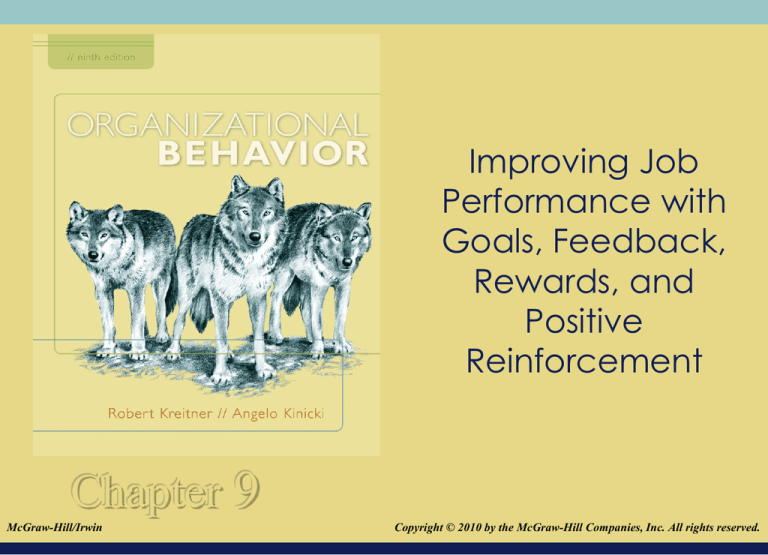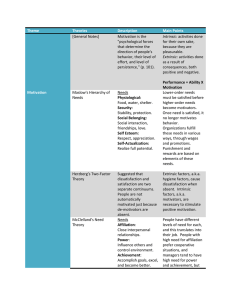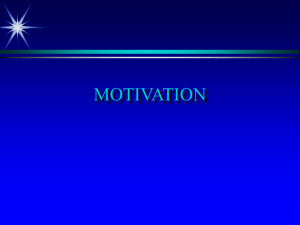
Improving Job
Performance with
Goals, Feedback,
Rewards, and
Positive
Reinforcement
Chapter 9
McGraw-Hill/Irwin
Copyright © 2010 by the McGraw-Hill Companies, Inc. All rights reserved.
© 2008The McGraw-Hill Companies, Inc. All rights reserved.
Ch. 9 Learning Objectives
1. Define the term performance management,
distinguish between learning goals and performance
outcome goals, and explain the three-step goal
setting process.
2. Identify the two basic functions of feedback, and
specify at least three practical lessons from feedback
research.
3. Define 360-degree feedback, and summarize how to
give good feedback in a performance management
program.
4. Distinguish between extrinsic and intrinsic rewards,
and explain the four building blocks of intrinsic
rewards and motivation
9-2
Ch. 9 Learning Objectives
5. Summarize the reasons why extrinsic rewards often
fail to motivate employees.
6. Discuss how managers can generally improve
extrinsic reward and pay for performance plans.
7. State Thorndike’s “law of effect,” and explain
Skinner’s distinction between respondent and
operant behavior.
8. Define positive reinforcement, negative
reinforcement, punishment, and extinction, and
distinguish between continuous and intermittent
schedules of reinforcement.
9. Demonstrate your knowledge of behavior shaping.
9-3
Your Experience
A=Yes, B=No, C= NA
1. Have you had a performance management
discussion with your manager?
2. Have you ever conducted a performance
management discussion with an employee?
3. Do you look forward to performance
evaluation meetings with your boss?
What would your ideal performance
management session be like?
9-4
Improving Performance
Performance
management
• Continuous cycle
of improving job
performance with
goal setting,
feedback and
coaching, and
rewards and
positive
reinforcement.
9-5
Improving Individual Performance
9-6
Goal Setting
Performance
outcome goal:
targets a specific
end result
Learning goal:
Encourages
learning, creativity,
and skill
development
9-7
Line of Sight
56% of workers in US
don’t “clearly
understand their
organization's most
important goals”
81% don’t have clearly
defined goals
Line of Sight:
Knowledge of the
organization’s
strategic goals and
how they need to
contribute
9-8
Guidelines for SMART Goals
9-9
Steps for Effective Goal Setting
Programs
1. Set Goals
• What do you base the goals on? How do you know
what is appropriate?
2. Promote Goal Commitment
• Under what conditions will an employee be motivated
to pursue a goal?
3. Provide Support and Feedback
• How will the employee reach the goal? What resources
will be necessary?
9-10
Feedback
Feedback objective
information about
performance
Functions of
Feedback
• Instructional
• Motivational
9-11
Six Trouble Signs For Organizational
Feedback Systems
1. Feedback is used to punish, embarrass, or put down
employees
2. Those receiving the feedback see it as irrelevant to
their work.
3. Feedback information is provided too late to do any
good.
4. People receiving feedback believe it relates to
matters beyond their control.
5. Employees complain about wasting too much time
collecting and recording feedback data.
6. Feedback recipients complain about feedback being
too complex or difficult to understand.
9-12
Nontraditional Feedback
360-Degree
Feedback
comparison of
anonymous feedback
from one’s superior,
subordinates, and peers
with self-perceptions
9-13
Tips for Giving Good Feedback
Focus feedback on performance, not
personalities
Give specific feedback tied to observable
behavior or measurable results
Channel feedback toward key result areas
Give feedback as soon as possible
Give positive feedback for improvement,
not just final results
Base feedback on accurate and credible
information
Pair feedback with clear expectations for
improvement.
9-14
General Model of Organizational
Reward Systems
Desired Outcomes
Types of Rewards
• Financial/material
(extrinsic)
• Social (extrinsic)
• Psychic (intrinsic)
Distribution Criteria
•
•
•
•
•
Attract
Motivate
Develop
Satisfy
Retain
• Results
• Behavior
• Other factors
9-15
Intrinsic vs. Extrinsic Rewards
Intrinsic
Rewards Selfgranted, psychic
rewards
What are examples
of intrinsic
rewards?
Extrinsic
Rewards
Financial,
material, or social
rewards from the
environment
What are examples
of extrinsic
rewards?
9-16
A Model of Intrinsic Motivation
Opportunity
Rewards
From
Task
Activities
From
Task
Purpose
Accomplishment
Rewards
Sense of
Choice
Sense of
Competence
Sense of
Meaningfulness
Sense of
Progress
9-17
Why Do Extrinsic Rewards Fail to
Motivate?
Too much emphasis on monetary rewards
Rewards lack an “appreciation effect”
Extensive benefits become entitlements
Counterproductive behavior is rewarded
Too long a delay between performance and rewards
Too many one-size-fits-all rewards
Use of one-shot rewards with a short-lived motivational
impact
Continued use of demotivating practices such as layoffs,
across-the-board raises and cuts, and excessive executive
compensation
9-18
Use and Effectiveness of Incentive Pay
Plans
9-19
Maximizing Motivational Impact of Extrinsic
Rewards
Make pay for performance an integral part of the
organization’s basic strategy.
Base incentive determinations on objective
performance data.
Have all employees actively participate in the
development, implementation, and revision of the
performance-pay formulas.
Encourage two-way communication so problems
with the pay-for-performance plan will be detected
early.
9-20
Maximizing Motivational Impact of Extrinsic
Rewards Cont.
Build the pay-for-performance plan around
participative structures such as suggestion systems or
problem-solving teams
Reward teamwork and cooperation whenever possible
Actively sell the plan to supervisors and middle
managers who may view employee participation as a
threat to their traditional notion of authority
If annual cash bonuses are granted, pay them in a
lump sum to maximize their motivational impact
Selectively use creative noncash rewards to create
buzz and excitement
9-21
Positive Reinforcement
Law of effect
• Behavior with favorable consequences is
repeated, behavior with unfavorable
consequences disappears.
I work really hard and am not rewarded. The
law of effect would suggest that I will
a. Quit
b. Keep trying to impress the right people
9-22
Behavior-Consequence Relationship
Contingent Consequences in Operant Conditioning
Nature of Consequences
Contingent
Presentation
Contingent
Withdrawal
Positive or Pleasing
Negative or Displeasing
Positive Reinforcement
Punishment
Punishment
(Response Cost)
Negative Reinforcement
(no contingent consequence)
Extinction
9-23
Test Your Knowledge
Martin’s boss tells him “the next time you come
to work late, I’m going to dock your pay”. This
best represents:
a.
b.
c.
d.
Positive reinforcement
Negative reinforcement
Punishment
Response Cost Punishment
9-24
Ten Practical Tips to Effectively Shape
Job Behavior
1)
2)
3)
4)
5)
6)
7)
8)
9)
10)
Accommodate the process of behavioral change.
Define new behavior patterns specifically.
Give individuals feedback on their performance.
Reinforce behavior as quickly as possible.
Use powerful reinforcement.
Use a continuous reinforcement schedule (for new
behaviors)
Use a variable reinforcement schedule for
maintenance
Reward teamwork -- not competition.
Make all rewards contingent on
performance.
Never take good performance for granted.
9-25






